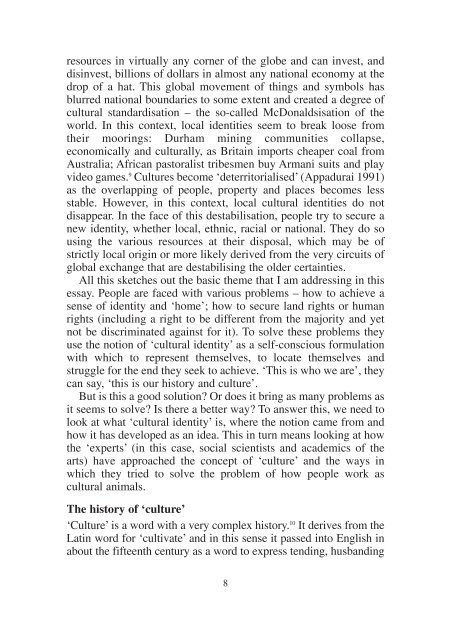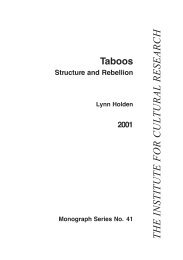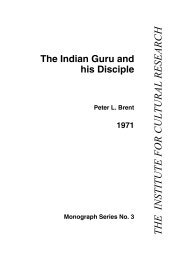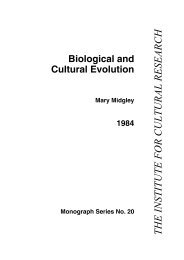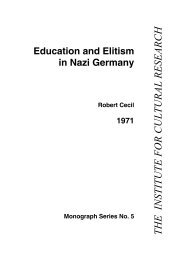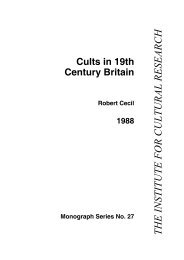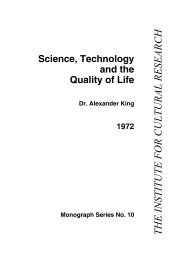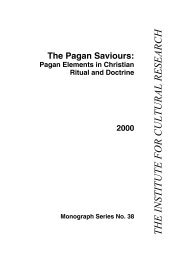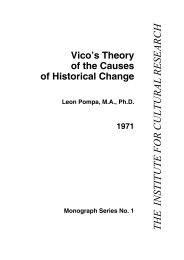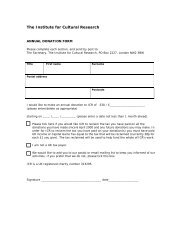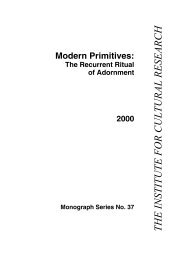Cultural Identity: Solution or Problem - The Institute For Cultural ...
Cultural Identity: Solution or Problem - The Institute For Cultural ...
Cultural Identity: Solution or Problem - The Institute For Cultural ...
Create successful ePaper yourself
Turn your PDF publications into a flip-book with our unique Google optimized e-Paper software.
esources in virtually any c<strong>or</strong>ner of the globe and can invest, and<br />
disinvest, billions of dollars in almost any national economy at the<br />
drop of a hat. This global movement of things and symbols has<br />
blurred national boundaries to some extent and created a degree of<br />
cultural standardisation – the so-called McDonaldsisation of the<br />
w<strong>or</strong>ld. In this context, local identities seem to break loose from<br />
their mo<strong>or</strong>ings: Durham mining communities collapse,<br />
economically and culturally, as Britain imp<strong>or</strong>ts cheaper coal from<br />
Australia; African past<strong>or</strong>alist tribesmen buy Armani suits and play<br />
video games. 9 Cultures become ‘deterrit<strong>or</strong>ialised’ (Appadurai 1991)<br />
as the overlapping of people, property and places becomes less<br />
stable. However, in this context, local cultural identities do not<br />
disappear. In the face of this destabilisation, people try to secure a<br />
new identity, whether local, ethnic, racial <strong>or</strong> national. <strong>The</strong>y do so<br />
using the various resources at their disposal, which may be of<br />
strictly local <strong>or</strong>igin <strong>or</strong> m<strong>or</strong>e likely derived from the very circuits of<br />
global exchange that are destabilising the older certainties.<br />
All this sketches out the basic theme that I am addressing in this<br />
essay. People are faced with various problems – how to achieve a<br />
sense of identity and ‘home’; how to secure land rights <strong>or</strong> human<br />
rights (including a right to be different from the maj<strong>or</strong>ity and yet<br />
not be discriminated against f<strong>or</strong> it). To solve these problems they<br />
use the notion of ‘cultural identity’ as a self-conscious f<strong>or</strong>mulation<br />
with which to represent themselves, to locate themselves and<br />
struggle f<strong>or</strong> the end they seek to achieve. ‘This is who we are’, they<br />
can say, ‘this is our hist<strong>or</strong>y and culture’.<br />
But is this a good solution? Or does it bring as many problems as<br />
it seems to solve? Is there a better way? To answer this, we need to<br />
look at what ‘cultural identity’ is, where the notion came from and<br />
how it has developed as an idea. This in turn means looking at how<br />
the ‘experts’ (in this case, social scientists and academics of the<br />
arts) have approached the concept of ‘culture’ and the ways in<br />
which they tried to solve the problem of how people w<strong>or</strong>k as<br />
cultural animals.<br />
<strong>The</strong> hist<strong>or</strong>y of ‘culture’<br />
‘Culture’ is a w<strong>or</strong>d with a very complex hist<strong>or</strong>y. 10 It derives from the<br />
Latin w<strong>or</strong>d f<strong>or</strong> ‘cultivate’ and in this sense it passed into English in<br />
about the fifteenth century as a w<strong>or</strong>d to express tending, husbanding<br />
8


